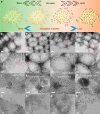Size-dependent activity and selectivity of carbon dioxide photocatalytic reduction over platinum nanoparticles
- PMID: 29593250
- PMCID: PMC5871894
- DOI: 10.1038/s41467-018-03666-2
Size-dependent activity and selectivity of carbon dioxide photocatalytic reduction over platinum nanoparticles
Abstract
Platinum nanoparticles (Pt NPs) are one of the most efficient cocatalysts in photocatalysis, and their size determines the activity and the selectivity of the catalytic reaction. Nevertheless, an in-depth understanding of the platinum's size effect in the carbon dioxide photocatalytic reduction is still lacking. Through analyses of the geometric features and electronic properties with variable-sized Pt NPs, here we show a prominent size effect of Pt NPs in both the activity and selectivity of carbon dioxide photocatalytic reduction. Decreasing the size of Pt NPs promotes the charge transfer efficiency, and thus enhances both the carbon dioxide photocatalytic reduction and hydrogen evolution reaction (HER) activity, but leads to higher selectivity towards hydrogen over methane. Combining experimental results and theoretical calculations, in Pt NPs, the terrace sites are revealed as the active sites for methane generation; meanwhile, the low-coordinated sites are more favorable in the competing HER.
Conflict of interest statement
The authors declare no competing interests.
Figures





References
-
- Marszewski M, Cao S, Yu J, Jaroniec M. Semiconductor-based photocatalytic CO2 conversion. Mater. Horiz. 2015;2:261–278. doi: 10.1039/C4MH00176A. - DOI
Publication types
LinkOut - more resources
Full Text Sources
Other Literature Sources
Molecular Biology Databases

